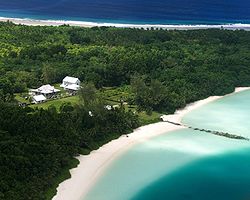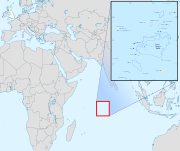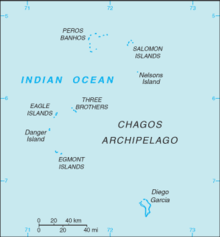Difference between revisions of "British Indian Ocean Territory"
m |
|||
| Line 5: | Line 5: | ||
|flag=Flag of the British Indian Ocean Territory.svg | |flag=Flag of the British Indian Ocean Territory.svg | ||
|arms=Coat of arms of the British Indian Ocean Territory.svg | |arms=Coat of arms of the British Indian Ocean Territory.svg | ||
| − | |map | + | |map=British Indian Ocean Territory location detail.svg |
|motto=In tutela nostra Limuria | |motto=In tutela nostra Limuria | ||
|capital=Diego Garcia | |capital=Diego Garcia | ||
Revision as of 11:19, 6 April 2020
| British Indian Ocean Territory (British overseas territory) | |
 East Point, Diego Garcia | |
|---|---|

| |

| |
| In tutela nostra Limuria | |
| Area: | 23.2 sq miles ‘’(land only)’’ |
| Population: | 4,000 |
| Capital: | Diego Garcia |
| Biggest town: | Diego Garcia |
| Time zone: | GMT +6 |
| Dialling code: | +246 |
| TLD: | .io |
The British Indian Ocean Territory (also known as the Chagos Islands) is an British overseas territory in the Indian Ocean, lying halfway between Africa and Indonesia. The territory comprises the six atolls of the Chagos Archipelago with over 1,000 individual islands and islets having a total land area of 23.2 square miles but somewhat more if lagoon areas are included.
The largest island is Diego Garcia with a land area of 11.6 square miles (or 65.6 square miles including the lagoon), the site of a joint military facility of the United Kingdom and the United States. Following the eviction of the native population in the 1960s, the only inhabitants are British and American military personnel and associated contractors, who collectively number around 4,000 (by 2004 figures).
Geography and communications
The territory is an archipelago of 55 islands, the largest being Diego Garcia, accounting for almost three-quarters of the total land area of the territory, which is 65.6 square miles including its lagoon. The terrain is flat and low, with most areas not exceeding 6 feet above sea level. The climate is tropical marine; hot, humid, and moderated by trade winds.
With the exception of one two-lane road, most of the islands in the territory have no roads of any sort. Diego Garcia has a short stretch of paved road between the port and airfield; otherwise most transport is by bicycle.
Diego Garcia's military base is home to the territory's only airport. At 3,280 yards long, it is capable of supporting very heavy USAF bombers like the B-52 and the Space Shuttle in the event of a mission abort. It also has a major seaport.
History
Maldivian mariners knew the Chagos Islands well.[1] In Maldivian lore they are known as Fōlhavahi or Hollhavai (the latter name in the closer Southern Maldives). According to Southern Maldivian oral tradition, traders and fishermen were occasionally lost at sea and got stranded in one of the islands of the Chagos. Eventually they were rescued and brought back home. However, these islands were judged to be too far away from the Maldives to be settled permanently by them. Thus for many centuries the Chagos were ignored by their northern neighbours.
The islands of Chagos Archipelago were charted by Vasco da Gama in the early sixteenth century, then claimed in the eighteenth century by France as a possession of Mauritius. They were first settled in the 18th century, by African slaves and Indian labourers brought by Franco-Mauritians to found coconut plantations.[2] In 1810, Mauritius was captured by the United Kingdom, and France ceded the territory in the Treaty of Paris.
In 1965, the United Kingdom split the Chagos Archipelago from Mauritius, and the islands of Aldabra, Farquhar and Desroches (Des Roches) from the Seychelles, to form the British Indian Ocean Territory. The purpose was to allow the construction of military facilities for the mutual benefit of the United Kingdom and the United States. The islands were formally established as an overseas territory of the United Kingdom on 8 November 1965. On 23 June 1976, Aldabra, Farquhar and Desroches were returned to Seychelles as a result of its attaining independence. Subsequently, BIOT has consisted only of the six main island groups comprising the Chagos Archipelago.
In 1966, the British government purchased the privately owned copra plantations and closed them down. Over the next five years, the British authorities removed the entire population of about 2,000 people from Diego Garcia and two other Chagos atolls, Peros Banhos and Salomon, to Mauritius.[3] In 1971, the United Kingdom and the United States signed a treaty, leasing the island of Diego Garcia to the American military for the purposes of building a large air and naval base on the Island. The strategic location of the island was also significant at the centre of the Indian Ocean, and to counter any Soviet threat in the region.
Work on the military base commenced in 1971, with a large airbase with several long range runways constructed, as well as a harbour suitable for large naval vessels. Although classed as a joint UK/US base, in practice it is mainly staffed by the American military, although a British garrison is maintained at all times, and Royal Air Force long range patrol aircraft are deployed there.
References
- ↑ Xavier Romero-Frias, The Maldive Islanders, A Study of the Popular Culture of an Ancient Ocean Kingdom. Barcelona 1999, ISBN 84 7254 801 5. Chapter 1 "A Seafaring Nation", page 19
- ↑ "Introducing the other Guantanamo", Asia Times, 17 Apr 2008
- ↑ "The coral sea vista opened up by British judges", Reuters, 25 May 2007

